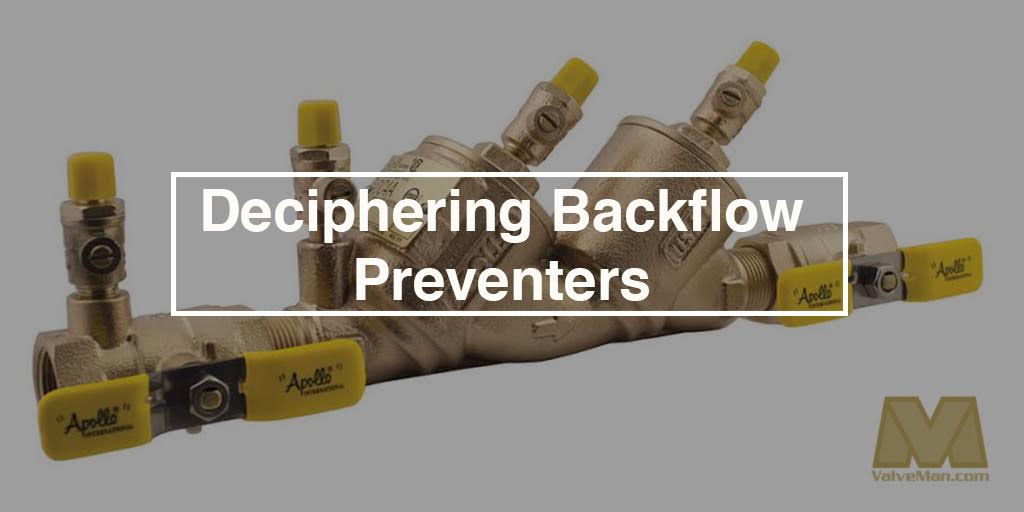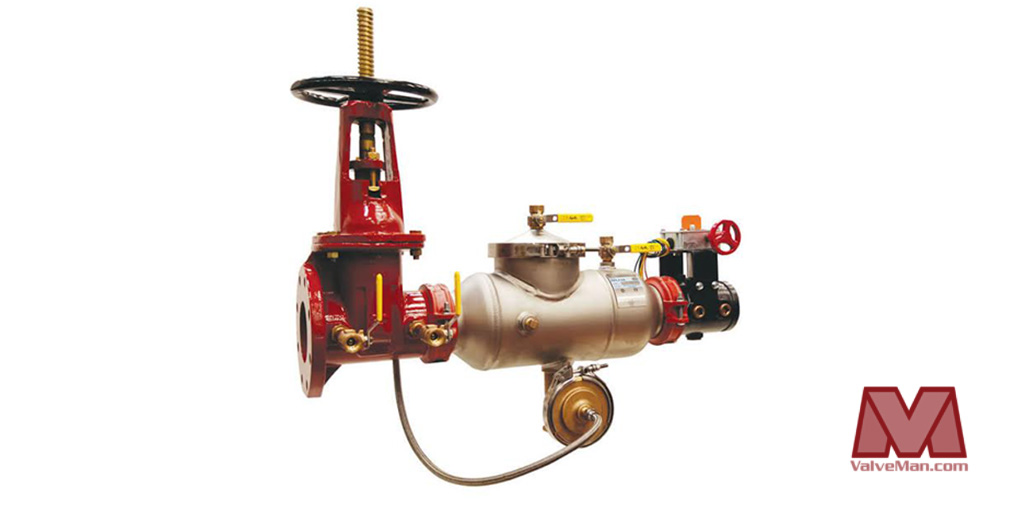What is a Backflow Preventer, and How Does it Work?
Posted by Gilbert Welsford, Jr on Apr 16th 2024
When a simple check valve is inadequate for the job, you need a backflow preventer. But knowing you need one and understanding how they work are two different things entirely. Unlike an inline check valve, which prevents fluid from traveling backward through the system, a backflow preventer is far more complicated, particularly because it does more than simply regulate backflow.
What is Backflow Prevention?
Backflow prevention refers to methods and devices used to stop contaminated water from reversing flow into the clean water supply. It safeguards drinking water systems from pollutants by maintaining a one-way flow using valves, air gaps, or specialized preventer devices.
Backflow is when fluids within a plumbing system runs in the opposite direction of where you want them to go. Let's say you're running an irrigation system, for instance. While connected water lines may run potable water supply and treated irrigation water side-by-side, a backflow of irrigation water into the potable water system would be disastrous, as it might lead to contamination of drinking water, resulting in disease and other health or environmental problems. Installing a backlow preventer is ideal in these cases.
There are two different types of situations to consider here. Back siphonage happens when there is negative pressure in the supply feed: a vacuum is created that allows water to siphon in the reverse direction. Backflow, on the other hand, is caused by back pressure--this happens when the pressure of the non-potable water is greater than the pressure of the drinking water as it is supplied from a distribution or source. Fluid flows from high to low pressure regions, resulting in contamination of the drinking water.

What is a Backflow Preventer?
Backflow preventers are plumbing devices designed to stop contaminated water from flowing backward into a clean water supply. They ensure water only flows in one direction to protect drinking water from pollution and contamination.
These devices are commonly used in commercial buildings, irrigation systems, fire sprinkler lines, industrial facilities, and many other applications where there’s a risk of cross-connection between potable and non-potable water. In residential settings, they’re often installed where outdoor irrigation lines, boilers, or secondary water sources connect to the main water line. They’re typically placed near the water meter or the main shutoff valve to prevent any backflow from reaching the municipal supply.
What is Backflow in Plumbing?
Backflow is when fluids within a plumbing system run in the opposite direction of where you want them to go. Let's say you're running an irrigation system, for instance. While connected water lines may run potable water supply and treated irrigation water side-by-side, a backflow of irrigation water into the potable water system would be disastrous, as it might lead to contamination of drinking water, resulting in disease and other health or environmental problems. Installing a backlow preventer is ideal in these cases.
There are two different types of situations to consider here. Back siphonage happens when there is negative pressure in the supply feed: a vacuum is created that allows water to siphon in the reverse direction. Backflow, on the other hand, is caused by back pressure--this happens when the pressure of the non-potable water is greater than the pressure of the drinking water as it is supplied from a distribution or source. Fluid flows from high to low pressure regions, resulting in contamination of the drinking water.
What Causes Backflow?
If you want to prevent backflow, it can be helpful to understand what causes it. In our experience, there are several different reasons why you may encounter backflow, including the following:
Backflow may be caused by improper pipe sizing, so ensuring appropriate sizing is essential to help prevent backflow. The wrong pipe sizes may lead to an increase in water pressure, causing backflows in certain parts of the system.
Temperature fluctuations can also lead to backflow. This is because the water pressure may change drastically in response to temperature changes, especially in the case of frozen pipes. The change in water pressure can easily lead to backflow in a different part of the system.
Another likely cause of backflow lies in sudden dips in water pressure. When there is a sudden dip in pressure on the main water supply line, the water pipes may begin pushing water backward to equalize the pressure in the system. This is also a type of backflow.
Finally, you may encounter a similar situation to the one discussed above, but from different causes. When there's an increase in water pressure on the receiving side of the water main, you'll also encounter backflow as the water pipes try to equalize the pressure vacuum formed by the sudden pressure changes. This is known as reverse pressure.

What is the Purpose of a Backflow Preventer?
The purpose of a backflow preventer is to prevent toxic sewage and other waste water from reversing flow and mixing with the clean water supply in a plumbing system. Having a backflow preventer installed is essential to protect a potable water supply line or to preserve sensitive equipment that only runs in a specific direction.
A backflow preventer is typically installed anywhere in a piping system that involves major cross-connections. For example, a water authority might require backflow preventers for fire protection systems. The backflow preventer’s job in this case, is to prevent non-potable fire fighting water from contaminating municipal potable water.
How does a backflow preventer work?
A backflow preventer works by using one or more check valves that only allow water to flow in one direction. If a sudden change in pressure occurs, like a burst pipe or pump failure, the device automatically shuts to block contaminated water from reversing into the clean supply.
When you take a closer look at the backflow preventer and how it works, you'll find that most backflow prevention assemblies rely on the use of check valves. Here’s how a backflow preventer works:
To prevent backflow, as well as back siphonage, a backflow preventer incorporates a series of check points that respond to pressure. These points are check valves that open and close, allowing upflow travel and stopping reverse travel.
There are two gates (i.e. check valves), an empty space between them, and a diaphragm that is activated by pressure. As upflow water pushes against the first gate, exceeding a preset psi, it is directed to the reservoir of the diaphragm. When cracking pressure is reached, the diaphragm depresses and closes a relief valve. As pressure builds, exceeding the next preset psi, the gate opens, allowing the chamber to fill.
Once this zone is filled, the second gate opens. This is normal water travel through a backflow preventer. When the inlet is shut off, both gates close and no backflow gets through.
Because of the double check valve design, combined with the diaphragm and relief valve, a backflow preventer is practically foolproof. Fouls like debris, which may force a gate to be stuck open, are managed by a pressure equalization that will open the relief valve, alerting you there is a problem. Likewise, backflow is prevented in the same way--the valves respond to pressure.
If backflow pressure is greater than upflow pressure, the second gate closes; if the second gate cannot close due to debris, the first gate will close, and the relief valve will open. Back siphonage is handled in the same way. Even if both gates are stuck open with debris, neither backflow nor back siphonage can contaminate the potable water, as the problem will be directed out from the backflow preventer via the relief valve.
Backflow preventers are applied anywhere there is a cross connection in a potable water system, as these systems also direct wastewater, sprinkler systems, fire sprinklers, etc. They are the fail-safe standing between you and unsafe drinking water.
What does a backflow preventer look like?
Backflow preventers are typically compact brass or stainless-steel devices installed near the main water supply line. They often feature one or more test cocks, shut-off valves, and a cylindrical or rectangular body. Their appearance may vary slightly depending on the type—like reduced pressure zone (RPZ) or double-check assemblies.

Types of backflow preventers
If you've been considering which plumbing device helps prevent a backflow, you already know that there are several types of backflow preventers on the market. Let's take a closer look:
Atmospheric Vacuum Breakers (AVB) are a type of backflow preventer that works well for low-hazard applications. These backflow prevention devices operate on a fairly simple concept, combining the mechanical abilities of a simple spring and a float. Typically, the pressure of the fluid opens the valve in the appropriate direction. However, when the system loses pressure due to backflow, the float falls, and the spring-loaded check valve closes.
The Pressure Vacuum Breaker (PVB) is more robust than the AVB system, but these backflow preventers work best for low to medium-risk applications, like your irrigation system or sprinkler system. It combines the mechanical properties of a spring, check valves, and a critical vacuum to help ensure that the system is protected against backflow.
A Double Check Valve Assembly (DCVA) has double check valves that are, arguably, more complex than those listed above. They're a better choice than pressure vacuum breakers for certain high-risk applications (fire sprinkler systems, for example).
A Reduced Pressure Zone Assembly (RPZA) is more advanced than some of the other listed options. These kinds of assemblies with reduced pressure zones are some of the most comprehensive backflow prevention systems on the market. In applications where it's vital to prevent contaminated water from entering your main water supply line, the RPZA system is ideal. It consists of several different parts, including:
- Dual check valves to ensure that, even if one valve fails, the system still prevents backflow
- A pressure relief valve in case the water pressure gets too high in the system
- A shutoff valve on both the inlet and outlet, for testing purposes.
These are the main types of backflow preventers available for purchase. If you’re going to buy one, we’d recommend the double check valve assembly or reduced pressure zone assembly for most applications.
Why You Should Buy a Backflow Preventer
We have found many benefits to installing a backflow prevention device. Some of these are fairly simple, while others make a significant difference. Let's discuss why you should consider purchasing one.
One of the many advantages is that a backflow preventer is extremely versatile. Backflow preventers work in many different scenarios, from an irrigation system to a fire hydrant and even a fire sprinkler system.
In our opinion, having a backflow preventer installed can also help safeguard your health. It does this by preventing contaminated water from entering potable water sources and preventing bacteria from entering places they don't belong.
If you want to comply with regulations, it can be essential to install backflow preventers where two or more pipes meet. Simple check valves generally aren't enough to qualify as a complete backflow prevention system, even though they may be sufficient to prevent backflow in certain cases.
We have found that installing a backflow prevention device is crucial to maintaining water quality. In some cases, the failure to install backflow preventers can lead to the contamination of an entire water source, rendering it unusable.
In our experience, these are just a few of the many reasons you might want to buy a backflow prevention device.
Why Maintaining Your Backflow Preventer is Essential
Your backflow prevention device requires general maintenance to ensure that it functions as well as it should. While most of the backflow preventers on the market have safeguards in place to prevent complete failure, there are still opportunities for failure when you don't practise regular maintenance.
So, what kind of maintenance should you be practicing with your backflow preventers?
- First, remember that it's best to leave the maintenance of this kind of backflow prevention system to certified professionals.
- Never deactivate or remove your backflow preventer, as you run the risk of contamination. In some areas, it may also be illegal to remove backflow preventers unless certain conditions have been met.
- Yearly testing of the backflow prevention system is a legal requirement in some states. Depending on the type of preventer used, testing may have to happen more regularly. Double check valves require checks every three years, while reduced pressure zone preventers require yearly checks.
- It's important to do regular visual checks on your backflow prevention system. Check for cracks, leaks, or any other signs of damage. If the system needs repair or replacement, it's best to get that done as soon as possible.
Where to Buy Backflow Prevention Systems
When you need to prevent backflow in your system, or backflow prevention is a legal requirement for your industry, you're in the right place. In fact, you can find backflow preventers--made by Apollo--right here on our website.
We also stock a whole range of other valves and equipment to help you equip your system as well as possible.
If you've enjoyed this tidbit about backflow preventers, you may also like other articles such as T-Port Vs. L-Port or Why Choose Apollo Ball Valves. If you have additional questions about backflow prevention, or you'd like help with your particular system, feel free to contact us; we'd love to help you.
Resources
https://plumbingtoday.biz/blog/what-is-a-backflow-preventer-and-how-does-it-work# - Accessed 11/03/2024
https://goodbeeplumbinganddrains.com/what-is-a-water-backflow-preventer-and-why-do-i-need-one/ - Accessed 11/03/2024
https://todayshomeowner.com/plumbing/guides/backflow-preventer/ - Accessed 11/03/2024

 888-825-8800
888-825-8800










